10. Modern growth regulation systems in ornamental tree nursery
Authors: Magdolna Sütöri-Diószegi, Márk Steiner
The essential task of ornamental tree nursery production is to produce species- and varieties specific, healthy and sightly plants. To this end, beside the achievement of adequate growing conditions to the plants the application of growth-promoting and regulating methods is also important. It may be done phytotechnical, mechanical, and chemical ways. In this chapter potential methods of growth regulation will be reviewed.
10.1. Growth regulation in vegetative propagation
10.1.1. Autovegetative propagation
In ornamental tree nursery propagation active growth regulation may be applied in vegetative, especially autovegetative propagation.
10.1.1.1. Rooting stimulation in layering
Above-ground parts of the plant are rooted so by layering, that they stay in touch with mother plant, and fed by it while they do not have own roots. In different layering methods shoots or woody stems are covered by moist or loose soil to induce root growing. Rooting process may be accelerated by distraction of nutrient turnover in layered stem of difficult-to-root taxa (bark injuring, apply wire tourniquet, twisting of woody stem). Due to the injury or tourniquet, those nutrients and plant hormones, which transported downward, build up above the injured place, and therefore rooting starts here faster.
10.1.1.2. Rooting stimulation in cutting propagation
In the course of cutting propagation, horticultural specialists make stem, leaf or root of the plant regenerate, initiate adventitious roots and shoots. Adequate type of cutting propagation depends on species, varieties and rooting ability. Rooting is a very complex process, which is influenced by several factors. Most important ones are the followings:
- Propagated species, varieties
Rooting ability of different taxa is various.
- Condition of mother plant
Vigorous, well-rooted cutting can be picked from healthy, good conditioned mother plant only. Therefore regular pruning, irrigation and fertilization of the mother plants are indispensable.
- Date of propagation
Every plant should be propagated by cutting, when it gives the best result.
- Circumstances of cutting picking
Only those plants root well, which are picked freshly, not flagged and have abundant nutrient reserves. Therefore it is important to pick and cut cuttings in right time of the day, furthermore the professional storage up to planting.
- Nutrients and bioactive compounds, plant hormones
It is written about in detail in chapter 3.
- Picking place on mother plant
It is important, from which part of mother plant was the cutting picked.
- Presence of preformed roots
Those cuttings, which originate such mother plants, which have preformed roots, root easier.
- Physiological stages (adult or juvenile) of cuttings
Rooting ability of young, juvenile cuttings is far better. It is important especially in difficult-to-root plants to stay the mother plant in young stage as far as possible. There are many practices to rejuvenate mother plant for better rooting. These methods are called preconditioning: pick cuttings from young mother plants and rooted cuttings, regular pruning of mother plants, pick cuttings from forced plants, mother plant etiolation (with raising or black plastic), spaying mother plants with hormonal substances.
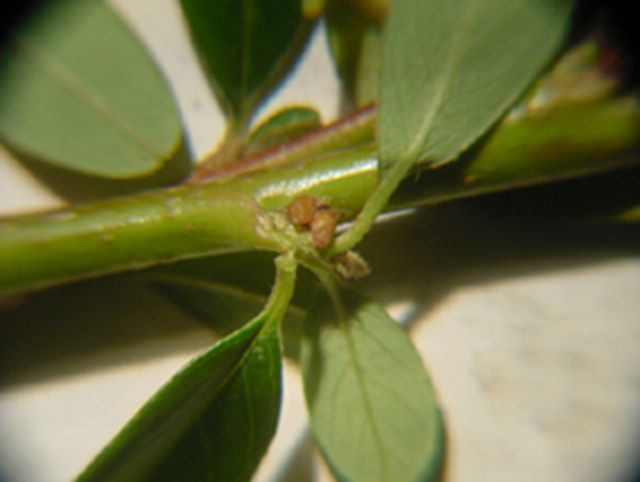
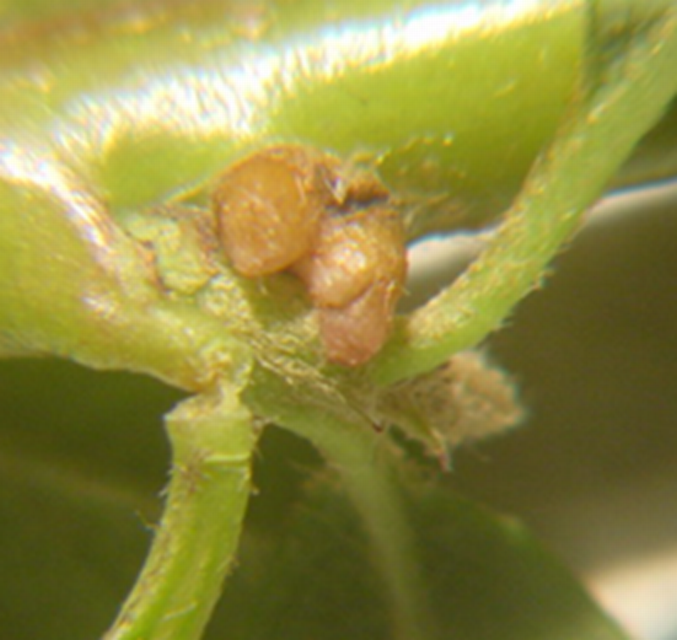
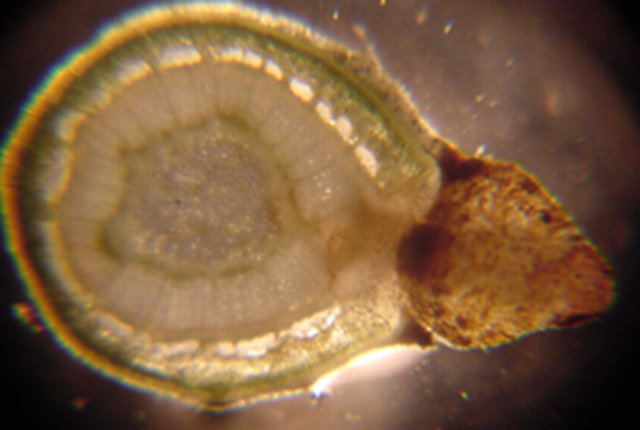
Demonstration of preformed roots on Cotoneaster × suecicus ’Skogholm’
Propagation with hardwood and root cuttings is the simplest way of it, which is done usually in open ground. In these cases rooting stimulation is rarely applied. However, bottom treatment of cuttings may be required in difficult-to-root species (e.g. storage in deep bed, bottom heat treatment, hardwood cutting in conditioned greenhouse).
Contrarily, softwood cuttings, which may be green or semi-ripe in evergreen taxa, are propagated mostly under controlled conditions in greenhouse, where rooting can be influenced most favourably by regulation of environmental factors (light, humidity, temperature, medium).
Rooting may also be stimulated mechanically; an example could be the injuring of cutting stem or bottom, which causes adventitious root formation. In the case of some species (e.g. Thuja, Platanus), satisfactory rooting can be reached by the so called mallet cuttings, which include an older wood at the base.
The success of cutting, the rooting may also be subserved by the application of chemicals, rooting hormones. It has outstanding importance mostly in difficult-to-root taxa. Heteroauxin (beta-indoleacetic acid, IAA) is the most common rooting hormone however this natural compound is replaced in our days by synthetic related compounds, which are the followings:
- beta-indolebutyric acid (IBA),
- alpha-naphthylacetic acid (NAA).
These two chemicals soluble in organic solvents (acetone, alcohol) only. Their advantage is, that they are more stabilised compared to natural auxin, and they may be kept for as concentrated solution or powder up to several months. Three methods are used widespread in the practice for rooting stimulation of cuttings:
- dipping into talcum containing active substance
- short dipping into concentrated solution
- long-term immersion into dilute aqueous solution.
Principally, dipping into talcum powder and alcoholic solution are applied in the practice.
Compounds may be done at home by using IBA or NAA, and alcohol or talcum in different types and concentrations, but many types of them are available in the European markets offered under several trade-name. Seradix®, Murphy Hormone Rooting Powder®, Rhizopon® and Boots Rooting Powder® are powdered preparation. Incit, Semiramis rooting powder and Radistim are commercially-available in Hungary. Application of hormone powders is easier and requires less skill, and there is no risk of scorching of cuttings. Contrarily, using of alcoholic compounds needs attention and technological discipline; it may be suggested only for experienced specialists.
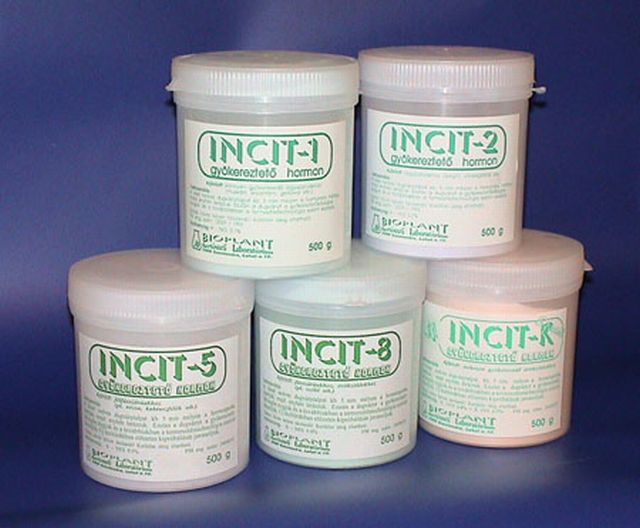
Incit-series
10.1.2. Xenovegetative propagation
In the course of budding and grafting, growing character of future grafted tree is influenced largely by selection of grafted components. Rootstock utilization is still not so well-developed in ornamental plant production as in fruit or grape growing, because specialists work with a lot of species and varieties, and in other hand, produce fewer units in each plant groups.
According to practical experience and closer inspection of grafting, it is expedient to be rootstock and its scion as closely related species as it possible. If it is possible, scion variety is grafted into its own species or a closely related species. Rootstock selection is also influenced by rootstock-scion combination, if rootstock has a beneficial effect on growing of scion, for example it increases resistance against environmental factors (e.g. it enhances drought or frost tolerance), or affects on scion growing character (vigorous or dwarfing rootstocks). Good affinity between grafting partners must be kept in mind by all means; good union and compatibility is essential.
10.1.2.1. Rootstock utilization in conifers
In Pinus genus, after closely relationship it is subservient to graft 2-needle taxon into 2-needle one, and 5-needle into 5-needle one, however there are exceptions as well. Therefore, it is inexpedient to graft Pinus mugo variety into P. sylvestris or other vigorous 2-needle Pinus, because it may cause unfavourable changing in the habit of scion, for example habit loosening. Potential susceptibility of a rootstock to some pathogen may be a barrier, which is exemplified well by susceptibility of Pinus strobus to currant rust. Pinus mugo is suggested by professionals as rootstock of 2-neddle Pinus species as against the common used Pinus sylvestris due to its better root system. Practical experience has shown that Chamaecyparis obtusa ’Nana Gracilis’ grows more vigorous on Chamaecyparis lawsoniana rootstock, while it becomes more sensitive to frost on Thuja orientalis, and it gives more aesthetic plant on Thuja occidentalis rootstock. It is important to know that Cupressus macrocarpa ’Goldcrest’ becomes more frost-resistance on Thuja orientalis rootstock.
In Juniperus genus Juniperus virginiana, Juniperus chinensis ‘Hetzii’, Juniperus communis, andJuniperus excelsa ‘Stricta’ are deemed appropriate as rootstock. Furthermore, Thuja orinetalis may be applied as universal rootstock in Chamaecyparis, and Juniperus genera. In Thuja genus Thuja occidentalis and Thuja plicata rootstocks are recommended. In the case of Taxus genus Taxus baccata is the ideal rootstock.
Rootstock may have effect on aesthatic crown form. Experiments in Cupressaceae family shows that for example Juniperus chinensis ’Keteleerii’ has slim crown on Juniperus virginiana, while it disintegrates on other rootstock. Similar phenomenon was observed in Chamaecyparis lawsoniana ’Stewartii’, which grown most beatifully on its own species.
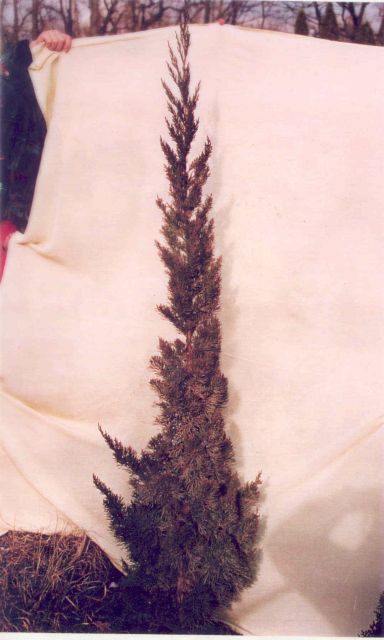
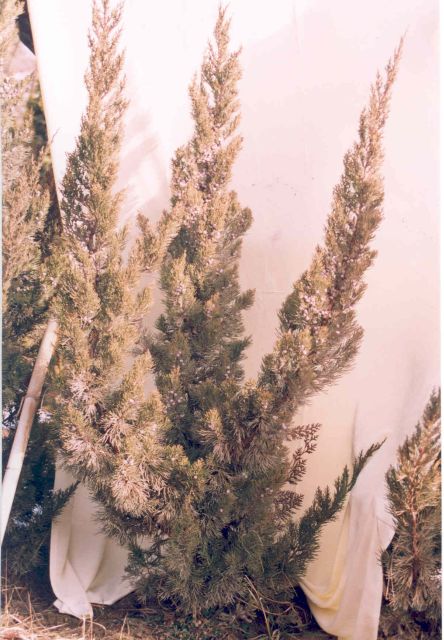
Rootstock effect in Cupressaceae family
left: Juniperus chinensis ’Keteleerii’ on Juniperus virginiana
right: Juniperus chinensis 'Keteleerii' on Thuja orientalis
Rootstock-scion combinations of conifers (BEZÁK et al., 1996)
|
Rootstock |
Scion |
|
Abies alba, Abies nordmanniana |
Abies species and varieties |
|
or Abies alba and A. nordmanniana |
|
|
Calocedrus decurrens, Thuja occidentalis |
Calocedrus decurrens forms |
|
or Chamaecyparis lawsoniana |
|
|
Cedrus deodara |
Cedrus atlantica verieties |
|
Cedrus deodara varieties |
|
|
Cedrus libani varieties |
|
|
Chamaecyparis lawsoniana,C. obtusa, C.thyoides |
C. lawsoniana ‘Alumii’, C. pisifera és ‘Squarrosa’ or other C. lawsoniana and C. pisifera varieties |
|
Chamaecyparis pisifera ‘Plumosa’ |
Chamaecyparis obtusa varieties |
|
Thuja occidentalis |
Chamaecyparis obtusa varieties |
|
Cupressus macrocarpa |
Cupressus glabra ‘Pyramidalis’ |
|
Cupressus glabra varieties |
|
|
Cupressus sempervirens varieties |
|
|
Thuja orientalis |
Chamaecyparis nootkatensis varieties |
|
Juniperus virginiana |
Juniperus virginiana varieties |
|
Juniperus chinensis ‘Hetzii’ |
Juniperus scopulorum varieties |
|
Juniperus scopulorum varieties |
|
|
Larix decidua, L. kaempferi |
Larix decidua, L. kaempferi |
|
P. abies |
Picea varieties |
|
P. strobus, P. wallichiana |
Pinus varieties with 5-needle |
|
P. contorta, P. strobus |
P. pumila species and varieties |
|
P. ponderosa |
Pinus varieties with 3-needle |
|
P. contorta, P. sylvestris |
Pinus varieties with 2-needle |
|
P. menziesii |
Pseudotsuga species and varieties |
|
T. baccata |
Taxus species and varieties |
|
T. occidentalis |
Thuja vigorous species and varieties |
|
T. canadensis |
Tsuga species and varieties |
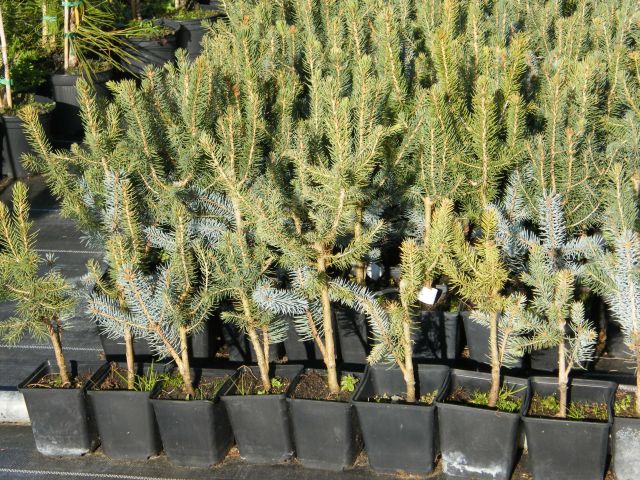
Picea pungens ’Koster’ on Picea abies rootstock
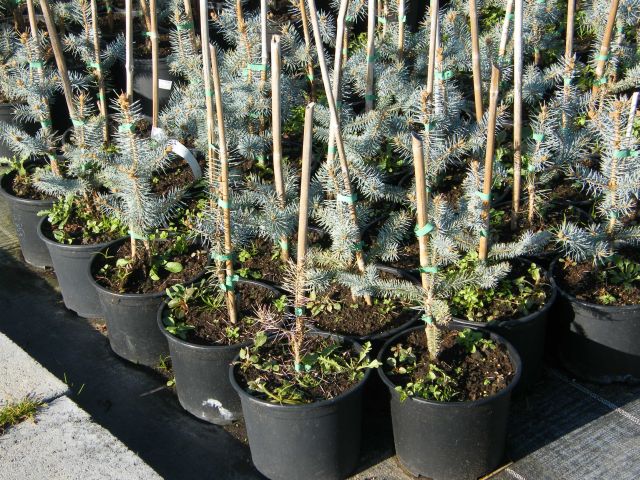
Picea pungens ’Koster’ on Picea abies rootstock
10.1.2.2. Rootstock utilization of broad-leaved trees and shrubs
Grafting partners are selected in this group as well after practical experience, which relies for the most part on the practice of fruit growers. For example, ornamental plums, cherries, apples are budded into rootstock varieties, which are used by fruit growers, too (e.g. M4 and M16 apple rootstocks for ornamental apples).
10.2. Mechanical growth regulation of ornamental trees and shrubs
Pruning and other phytotechnical actions have significant role in growth regulation of woody ornamental plants. Pruning is necessary during both production and nursing of ornamental trees and shrubs, however not so regularly as in the case of fruit trees and vines, where regular and rich fruiting should be ensured. The aims of the pruning of woody ornamentals are the followings: forming and maintenance of species- and variety-specific crown form, ensuring of growing, vigorous and healthy foliage and the magnificence of flowers and fruits. Ornamental trees and shrubs require pruning in the course of nursery growing, planting and transplanting, crown shaping, then after their sale. Later, their crown should be corrected and formed only occasionally, and shrubs should be made younger.
10.2.1. Nursery growing of deciduous shrubs
In the case of shrub production the most important aim is to produce more branched plants, which have at least 4-5 shoots closed to the ground.
10.2.1.1. Own-root shrubs
It may occur that a vigorous, well-branching shrub, which was planted in the spring, can be sold in the autumn of the same year without any interference. But the most shrubs have only 1-3 shoots after planting. If their height reaches 15-25 cm, it is worth heading back their shoots above the 2nd or 3rd bud in late May or early June to induce branching. If the shrub has only one shoot, it should be cut back to 4-6 buds. By autumn, shoot system is mostly still undeveloped therefore it is worth heading back the plants to 2-3 buds in the next spring, and so plants will have adequate number and strength of shoots to next autumn.
10.2.1.2. Budded shrubs
Nursing of fall budded shrubs (e.g. Prunus triloba ’Multiplex’) is much more labour-intensive. In the first growing season rootstock plants strengthen, and than fall budding is carried out between July and September. In next spring rootstocks cut back to the bud. If probably an erectly shoot grows from scion bud, rootstock should be headed back with a slightly obliquely cutting directly above bud piece. If a weak or curved shoot sprouts out from the scion bud, it is worth leaving a 10-15 cm long snag, and if the length of scion shoot reaches around 15 cm, it may be fixed to the snag. The buds of the snag must be rubbed off.
If the shoots have already a length of 20-25 cm, upper third should be cut back, and the lower part will start feathering. If the buds of rootstock sprout out, they must be rubbed off. It is referred by nursery people as suckering.
Snag may be headed back immediately above the bud after strengthening of the shoot (usually in July). Stubs should be not left.
Vigorous and well-feathering shrubs may be sold in the next autumn after budding. The weaker ones should be cut back in the following spring to 4-6, or the more feathered ones to 2-3 buds then the well-feathered shrubs may be sold in the autumn.
10.2.2. Nursery growing of broadleaf evergreen shrubs
Their nursing is similar to own-root shrubs, but after planting their heading back is only necessary if their branch system is still not enough feathered, or if their correction is required. In the case of those shrubs, which are more sensitive to winter frost (e.g. Aucuba japonica), application of nitrogen fertilizers should be stopped in early July, respectively irrigation moderated from the middle of August, and so the shoots can get in, their frost tolerance and hardiness improve. Whereas evergreen shrubs are sold with root ball, plants should be transplanted in every 2-3 year to ensure strong root system.
10.2.3. Nursery growing of deciduous trees
Tree growing takes several years after the planting of young plants. The first step is mostly the building of an unfeathered, straight stem, then on it the shaping of species- and variety-specific crown. After planting of both own-root and grafted young plants only one shoot should be left by thinning , others should be removed completely. If whips grow weakly or askew in the first year, they should be headed back a few cm above the ground to a well-developed bud in the following spring. In several nurseries each young plant is headed back by this way so as to get homogenous, strong, erectly shoots. Those plants, which have a big terminal bud (e.g. Aesculus, Fraxinus) or tolerate heading back badly (e.g. Castanea, Quercus), should not be cut back.
Trees may be grouped under clear stem height as follows:
- street trees: clear stem height ≥ 220 cm
- high park trees: clear stem height 150-220 cm
- low park trees: clear stem height 60-150 cm
- multi-stemmed trees: more main stems arising from ground level
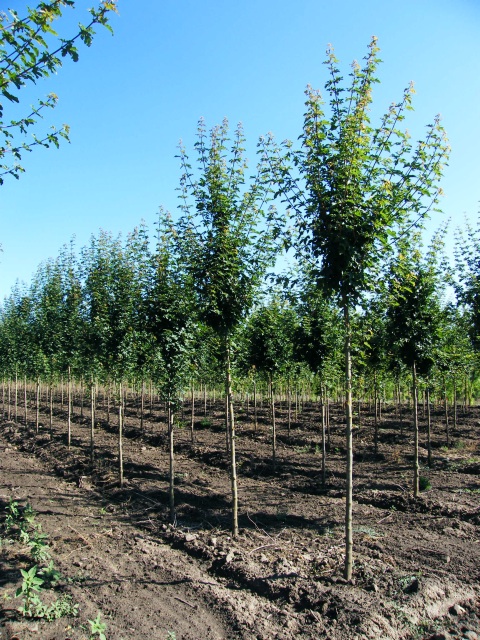
Street trees in nursery
Under stem building ability:
- good stem-builders: fast-growing trees having straight stem (e.g. Acer, Tilia), their stem is built by natural way, i.e. it grows continually from terminal bud.
- bad stem-builders: they grow curved stem (the reason may be the weak-growing species, damaged leader by frost, lack of terminal bud) – e.g. Celtis, Sophora. Their stem is build by artificial way: earlier by grow straight snag, nowadays rather by bamboo caning.
10.2.3.1. Nursery growing of once transplanted good stem-builder trees
It takes mostly 4 years. Whip growing is made in the first three years, then in 4th year crown is formed by topping. During these 4-5 years the following actions should be done:
- Remove the laterals: removing of 3-6 cm long axillary shoots from the trunk before they become woody.
- Growing stem strengthening snags: it helps to thicken stem. The laterals of leader are removed to a height of 40-50 cm above the ground. Above this, laterals are pinched back to 4-5 leaves, and they functional as stem strengthening snags: nutrients, which are produced in the leaves, accumulate in the stem and it thickens so. Snags, which are thicker than a pen, must be removed completely and over-dense ones must be thinned. They should be removed before sale in time that wounds can be healed.
- Pinching, topping: it is made commonly before bud break. If the stem exceeds the required height, tree crown must be formed. Its method is the following: 5-6 buds are left above the required clear stem height. Furthermore, 8-10 cm long grow straight snag is left (buds of the snag must be rubbed off), and the leader of the whip is headed back above this. Crown shoots shapes from the left 5-6 buds.
- Shoot removing below the crown: fully removing of 4-5 shoots below the crown to allow it to grow undisturbedly. ((disz1.jpg)): shoot removing below the crown
In the case of vigorous species, the crown develops in one year, while it may takes two years in weaker ones. In second year spring, crown shoots are cut back strongly to an outward facing bud.
10.2.3.2. Nursery growing of once transplanted bad stem-builder trees
It is made by caning, clear-cutting or by the so-called artificial stem-building. In artificial way, the curved stem is headed back before bud break to an opposite sides bud at the beginning of the bend. Buds should be rubbed off from the upper 20-25 cm of the leader to allow the crown to grow undisturbedly. Shoots sprouting from lower buds should be thinned.
10.2.3.3. Nursery growing of once transplanted, low and top budded trees
Tree growing could be made easier by grow straight snags.
10.2.3.4. Production of semi-mature and mature trees
If the production of large scale, immediate decorating trees is required, once transplanted trees may be planted again after lifting in the nursery, and this process may be repeated 4-6 times, which causes very valuable trees. Root system should be cut back before transplantation that it grows as feathered as possible in a restricted root space. Additionally, crown shaping is needed, too. Leaders should be headed back by half while side shoots by up to two-third. In next years, crown shoots should be cut back regularly in order to ensure dense and well-feathered crown.
10.2.4. Pruning of conifers
Conifers are planted with root ball in the nursery; usually their initial heading back is unnecessary.
10.2.4.1. Crown shaping opportunities of whorl-branched conifers
Pruning is applied rarely to induce feathering in conifers. The most common process is the heading back of young shoots of Pinus genus in ‘candle stage’ by up to two-third.
However, mainly in Christmas tree production, members of Abies and Picea genera are pruned and shaped according to the newest Western European, Danish and German technologies and the Hungarian observations.
Three kinds of shaping activity can be differentiated:
- corrective pruning,
- shaping,
- growth regulation.
By corrective pruning, major non-conformities are handled in the crown (e.g. removing of double leader). If there are more leaders, those one should be left during young plant growing and mostly at planting, which has the better position. Removing should be done in the nursery in last growing season to heal injuries quickly and purely before dormancy period.
Shaping processes can get around growth defects, best quality can be received by them as soon as possible. Usually, they are applied, if terminal shoot is hurt by any kinds of external factor (late frost, bird damage, etc.). Major shaping processes:
- Growing leader from side shoot: it means the correction of terminal shoot, if a side shoot becomes leader with the using of stakes and plastic templates. Care should be taken to supporting materials and ligaments not to cut later into the bark.
- Whorl thinning: Branch thinning of whorl-branched conifers (e.g. Christmas tree) is applied in Hungary slightly, however, in addition to the correction of quality defects (for example, if the crown is too rare on top and dense below) selective thinning of lower branches provides the ventilation of tree canopy.
Growth regulation is applied in whorl-branched conifers, if for example the leader starts to grow in the 3rd-4th year after planting, but often more strongly as it would be optimal. Growing can be reduced by the following mechanical treatments (they block the nutrient transport system partially):
- Incision with Top-Stopp pliers: making an injury on the bark with a special scissors. The action is called ringing as well, if the bark is cut into till the cambium on either side of the shoot. One year old leader may be incised in the spring before the beginning of shoot growing.
- In the course of snag pruning, assimilating surface is reduced. At the lower part of the trunk, side shoots are cut back to 20-25 cm long snags, which moderates shoot growing.
- By root pruning and undercutting, nutrient uptake of the plant can be controlled, therefore nutrient transport is limited, and longitudinal growth of the shoots decreases.
10.2.4.2. Crown shaping opportunities of procumbent conifers
This process is applied mostly on squamous prostrate evergreens. If the crown is not evenly concentric, but irregular, too sparse or asymmetric, crown defects could be remedied by heading back of branches up to their half or third.
10.2.5. Primal tools of mechanical growth regulation
The following tools (non exhaustive list) are used in the ornamental tree nursery for growth regulation: pruner (hand, lopper, telescopic), billhook, saws, pruning scaffold and trolley, bamboo canes, plant ties, spade, hole driller, tree lifting machines, jute texture, wire mesh basket.

Planter
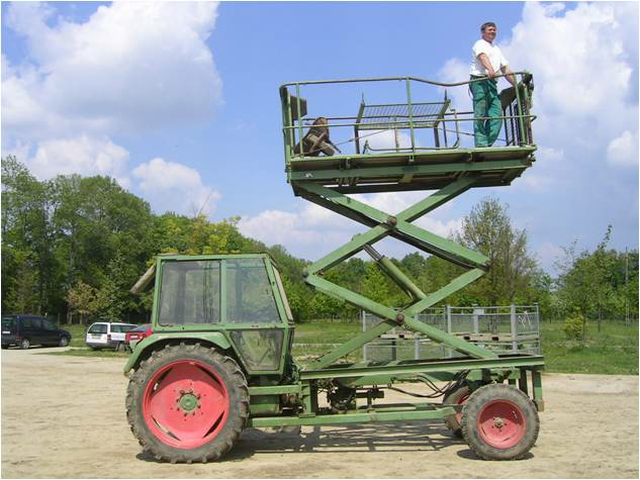
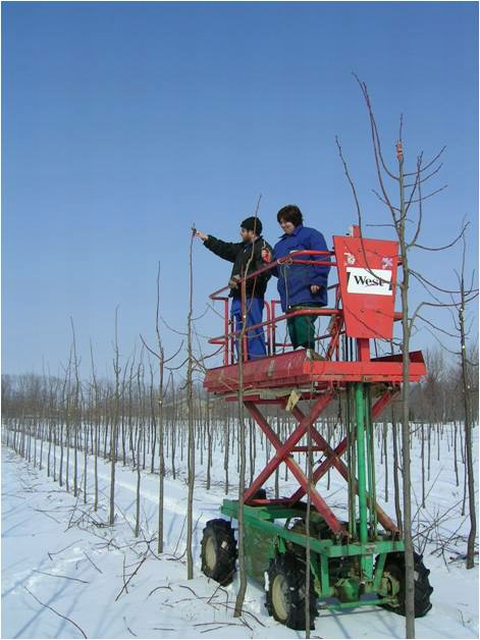
Machines of pruning
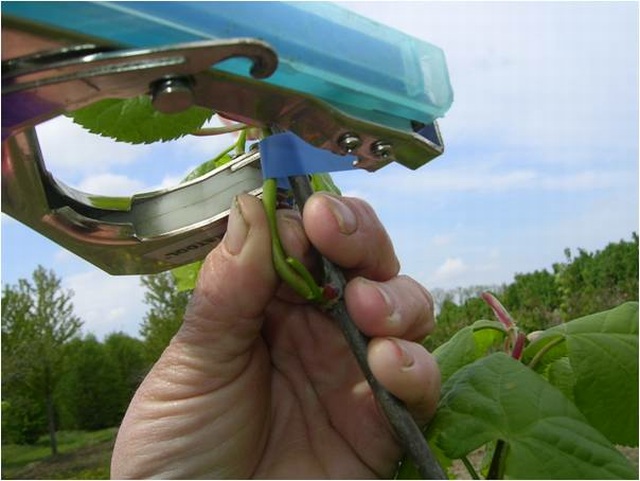
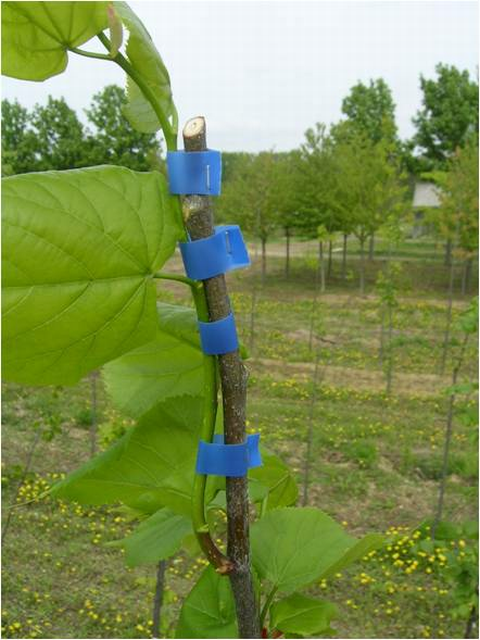
Max Tapener banding machine and use of it

Damcon Select lifter
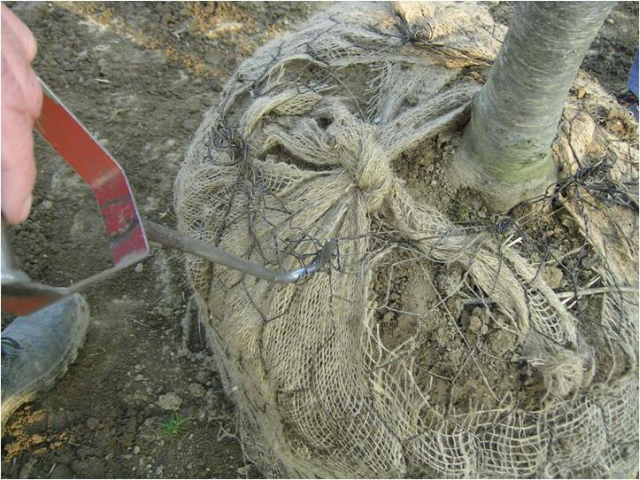
Wire ball

Forklift

Special trailer for trees

Air-Root container family
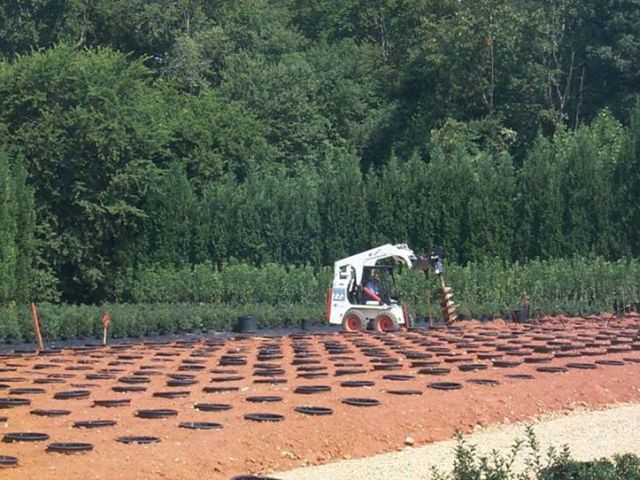
Pot-in-pot system
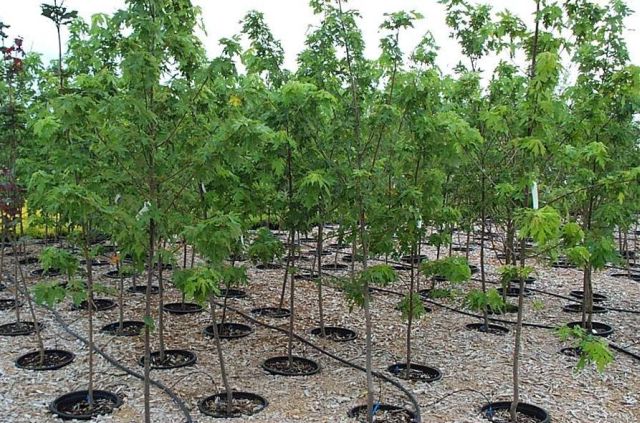
Pot-in-pot system with mulch
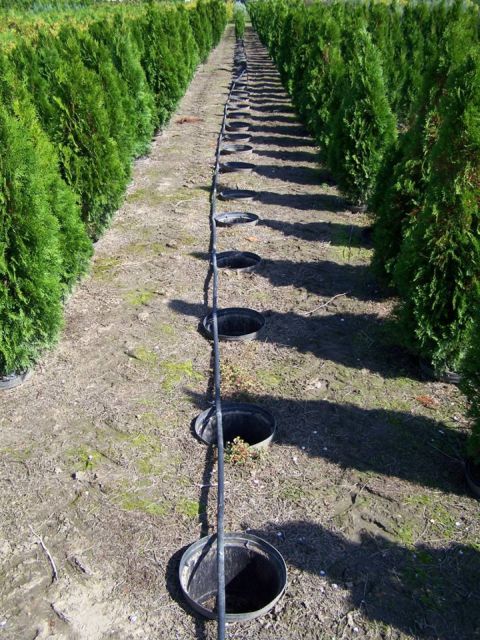
Cultivation of Thuja occidentalis ’Smaragd’ in pot-in-pot system
10.3. Chemical growth regulation
There is ambition also in the Hungarian ornamental nursery production – partly under the duress of EU regulation – to use less chemicals, fertilizers and pesticides under the cultivation. At the same time, the application of natural formulations, which save the environment and additionally have favourable effect on physiological processes and on the quality of nursery products, comes to the front. These compounds are also known as biostimulators or rather bioregulators. Bioregulators are plant hormones, whom active substance can be exactly identified chemically, or synthetic molecules, which have influence on hormonal balance and have positive impact on plant physiological processes.
Biostimulators (also called plant conditioner) are made of natural component (for example algae), therefore their content can not be defined precisely. They stimulate the life processes, because they contain hormones and substances (mostly microelements, nitrogen, phosphorus, calcium, magnesium, enzymes, coenzymes and amino acids), which promote the smooth functioning of plant life processes, the development and maintenance of nutrient harmony.
Their using improves the resistance of the plant to environmental conditions (e.g. drought, stress) and harmful organism (e.g. fungi), and herbicide tolerance of the plant gets better. In the case of their application, plants become more vigorous, greener, stronger, fruit set may increase and shelf life improves. Plant cultures need less plant protection treatments due to their application, because plants become more vital and tolerant.
Nowadays, different growth regulators and plant conditioners are important supplements of the production. They are not specifically pesticides, however they are reckoned among them by EU plant protection regulation. Earlier, they were used in vegetable growing, arable crop (for example cereals) production and in cultivation of herbaceous ornamental plants, but it is reported recently about awareness-raising results in fruit and ornamental tree nursery, too.
Growth regulators currently on the market may be listed under more big groups:
- Growth retardants: e.g. Cycocell 460, Stabilan, Moddus, Regalis, Folicursolo, Caramba SL
- Growth stimulants: e.g. preparations with a basis of gibberellic acid (GA3, GA4+7)
- Fruit setters, thinners: e.g. Nevirol 20 és 60, Dirigol N
- Yield stimulants: e.g. Ethrel
- Germination inhibitors: e.g. Neostop L 500, Gro-Stop HN, Fazor 80 SG
- Rooting stimulants: e.g. Óbudahorm, Incit
- Plant conditioner: e.g. Atonik, Frigocur
The aim of the ornamental tree nurseries is to produce well-feathered woody plants, which have well-branched and taxon-specific crown. Fruit growers also prefer trees, which have significant number of secondary shoots, for planting intensive orchards, and the results of the experiments with bioregulators are very positive on several species. In the Department of Floriculture and Dendrology, Faculty of Horticultural Science, Corvinus University of Budapest, numerous scientific articles and student researches were done on the subject of nursery tree growing and crown shaping with growth regulators, which can be summarized shortly as follows:
Different chemicals are examined for long times to induce branching and improve root quality. Very good results were achieved by cytokinin analogue benzyladenine, or rather gibberellin treatments. The co-administration of these compounds (for example in product Promalin) causes the sprouting out of summer buds however American investigations showed, that gibberellins may reduce the effect of benzyladenine. Latest results shows, that adequate length of shoots can be obtained by single application of benzyladenine and gibberellins (Hrotkó et al 1996). In early summer, branching can be improved by the spraying of auxin inhibitor M&B 25-105 (n-propyl-3-t-butylphenoxyacetate), which temporarily inhibits the auxin transport from the shoot tip, and so affects the sprouting out of axillary buds (Quinlan 1980, Howard 1987).
Under Hungarian circumstances, Paturyl 10 WSC containing benzyladenine (developed by Research Centre for Fruitgrowing and Extension, Újfehértó and Reanal Finechemical Private Ltd.) was applied effectively to induce feathering in young apple orchard (Bubán and Vásárhelyi 1988, Bubán et al 1990). The staffs of Corvinus University of Budapest have also made investigations with Paturyl since 1993, and they have got positive results on improving feathering of apple, pear, sweet and sour cherry nursery trees. Tween 20 non-ionic surfactant was applied during the treatments, and plants were treated by Volldünger and Sequestren foliar fertilizers after the emergence of secondary shoots. Due to the Paturyl treatments, root system branched better as well, and the trees had more sylleptic shoots compared to pinched trees. After Hungarian and foreign experiences, it is worth using this product on two-years-old headed back nursery trees. The combination of Paturyl treatment with the removing of subterminal leaves resulted 2-3 times more lateral shoots, and increased the number of fruiting branches significantly. Secondary shoots had greater crotch angle compared to acute angled shoots on pinched trees. Root system of the nursery trees was branched better, however had thinner root branches.
Most important plant growth regulators applied in the experiments are introduced in the followings.
10.3.1. Kelpak
This product contains Ecklonia maxima. This kelp species living in deep-sea is the member of brown algae (Phaeophyta); it is classified in the class Heterogeneratae and the order Laminariales. (Senge et al 1977). It grows in the clean, cold waters off the Atlantic Coast of Southern Africa, and makes kelp forests. Due to the endangered and sensitive ecology which thrives in these kelp colonies, divers harvest by hand. After that, raw material is processed, and valuable components are extracted. This product is made by the South African Kelp Products Ltd.
The composition of biostimulator is the following:
- 34.3% fresh Ecklonia maxima
- 66.5% water
- hydrogen peroxide 50 %
- 0.07% -0.09% acetic acid
- Sum of the biological active auxins: 10.7 mg·kg-1. Several of these are natural compounds with auxin property: indole-3-acetic acid, indole-acetyl-glycine, indole-L-aspartate, indolepropionic acid, indole-3-carboxylic acid, indole-3-aldehyde and indolelactic acid.
From among the components indolelactic acid, which causes stem elongation, is the best known. Additionally, the product contains 0.03 mg·kg-1 biological active cytokinins. It remains stable for 2 years on 30 ºC.
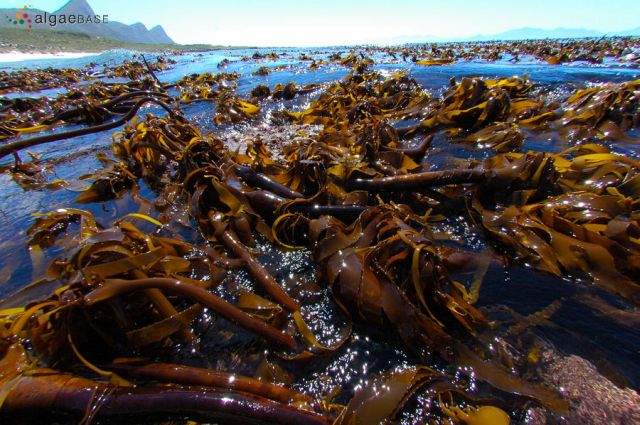
Ecklonia maxima brown alga in deep-sea
The experiments with the compound are really encouraging. Numerous proven results show its positive effect on increment of stem diameter and branching and growing of nursery trees. In the experiments of Corvinus University of Budapest, combined use of Kelpak and benzyladenine showed noticeable results on growing and feathering of nursery trees, because it induced the formation of secondary shoots and enhanced the root quality.
10.3.2. Wuxal® Ascofol
It is also a seaweed extract originated from Ascophyllum nodosum (Fig. XXX). This species, which belongs to brown algae (Phaeophyta), Cyclosporae family, Fucales order, lives in the north coasts of Atlantic Ocean, mostly in the North-East part of North America and the coasts of Northern Europe, but it can be found from Greenland to Portugal, too. Wuxal® Ascofol foliar fertilizer is made from brown alga extract, which is rich in microelements and natural plant growth regulators. It has the following composition:
- 2.5% N
- 1.25% K
- microelements
- plant hormones (e.g. cytokinin, gibberellin, auxin).
Wuxal is the first foliar fertilizer, which has not only essential nutrients, but also adjutants and environmentally friendly additives. It shows very positive results almost on all part of growing:
- it ensures prompt nutrient supply through the leaves,
- it can use in every culture,
- it induce stress tolerance of the plants,
- balanced, high primary nutrient content,
- whole and harmonious micronutrient range,
- it guarantees crop safety,
- it improves blooming and fructification.
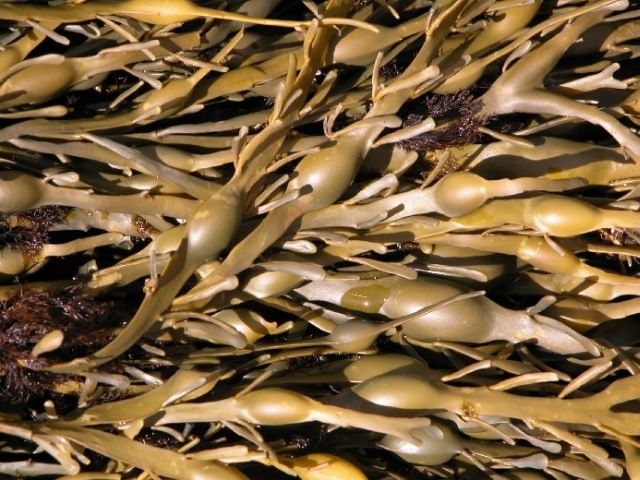
Ascophyllum nodosum alga
Wuxal, and its combination with benzyladenine had favourable effect on the initiation of lateral shoots both on fruit and ornamental trees in the nursery.
10.3.3. Ferbanat L
This compound is originally made by the Turkish Ekosistem company. In Hungary, it was allowed as ‘Bistep plant conditioner’ in 2011 November. Its favourable effect was described mainly under heat and/or cold stress conditions. Moreover, it increases proline levels and enhances fruiting. Main components (under marketing authorisation and application guidance):
- N content at least 0.02 % w/v
- P2O5 content at least 0.03 % w/v
- K2O content at least 0.3 % w/v
- vermicompost extract
- microorganisms
- macro- and microelements
- water.
In addition, the product has several beneficial bacteria (e.g. Pseudomonas putida, P. fluorescens és Bacillus subtilis) and fungi (e.g. the members of Nadsonia, Saccharomyces and Saccharomycodes genera) according to the distributors.
10.3.4. Yield Plus
This product is made by Pan Pacific Chemicals Ltd. New Zealand. This plant conditioner is a foliar fertilizer combined by the aforementioned Ascophyllum nodosum seaweed extract. Due to the brown alga content, this compound has also high hormone content, in addition to auxins and cytokinins it contains gibberellins and betaines, too. NPK rating is 5-4-11 and it contains the most important microelements as well (for example boron, iron, magnesium and manganese). There are also surfactants in it. Producer highlights its favourable effect on yields, fruit quality and shelf life. Composition of macro- and microelements:
- N content: 6 % w/v
- P content: 5 % w/v
- K content: 14% w/v
- Boron: 100 ppm
- Iron: 200 ppm
- Magnesium: 100 ppm
- Manganese: 200 ppm
- Molybdenum: 100 ppm
- Zinc: 200 ppm.
These products may be used for inducing feathering mostly in fruit tree nurseries, but also in ornamental nurseries on pome fruit and stone fruit trees.
Usually, dwarfing is not necessary in ornamental nursery growing. However, Cycocell treatment was tried in some Caryopteris species to produce compacter plants.
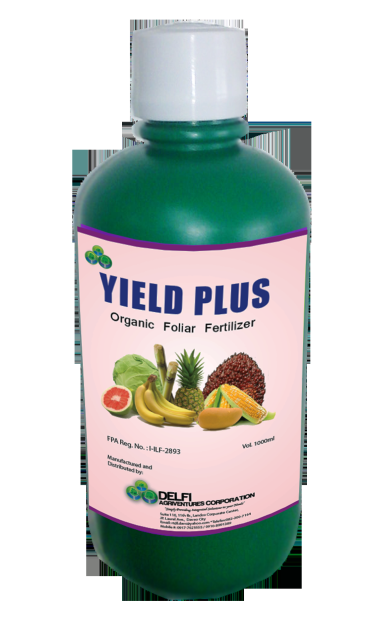
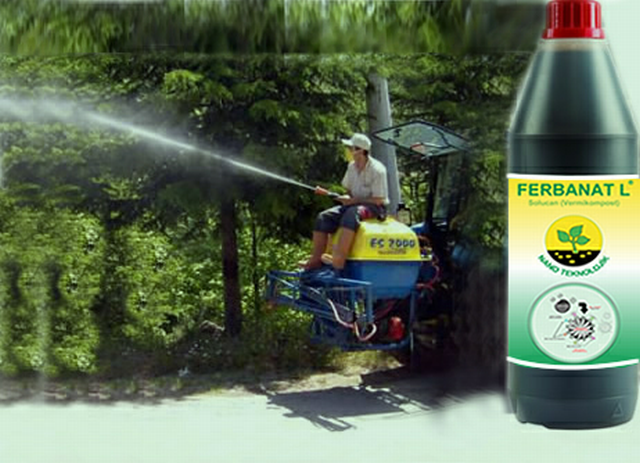
Biostimulators for nurseries
10.3.5. Chemical growth regulation of whorl-branched conifers
Chemical growth regulation of conifers is already not allowed and used in Hungary. However, the application of these compounds is very hazardous – especially in plants predisposed to russet – and therefore it is highly controversial. For example, Pomoxon is applied in Denmark, although it is not allowed in Germany. Its active substance is alpha-naphthyl acetic acid, which breaks free ethylene in the plant (it cause cell senescence), and shortens hereby the growing period and so the shoot length. In some cases, compound is sprayed, but more often, it is painted to the shoot tips with surfactant. Tebuconazole (trade name: Folicur) and propiconazole active substances (they have auxin effect similar to Pomoxon), furthermore prohexadione-Ca and mepiquat chloride (using single or combined with environmentally friendly additives – Agral, Silwert) may have chance to get authority.
Literature
- BÄRTELS, A.: 1985. Der Baumschulbetrieb. Ulmer Verlag, Stuttgart
- BÄRTELS, A.: 1989. Die Gehölzvermehrung. Ulmer Verlag, Stuttgart
- BEZÁK J., IFJU Z., SCHMIDT G.: 1996. Xenovegetatív szaporításmód-oltás. In Schmidt-Tóth, 1996.: Díszfaiskola. Mezőgazda Kiadó, Budapest 83.
- DIÓSZEGI M., SCHMIDT G.: 1992. Kézben oltás különböző alany-nemes kombinációkkal a Cupressaceae családban. „Lippay János Tudományos Ülésszak”, Budapest,
- DIÓSZEGI M., SCHMIDT G. 1996: Cupressus, Juniperus és Chamaecyparis fajták kézben oltása szabadgyökerű alanyra. Új Kertgazdaság. (4):85-88.
- DIÓSZEGI M., SCHMIDT G.: 1996. Az alany hatása a nemes növekedésére és fejlődésére a Cupressaceae családban. „Lippay János Tudományos Ülésszak”, Budapest
- DIRR, M.A.: 1990. Manual of Woody Landscape Plants: Their Identification, Ornamental Characteristics, Culture, Propagation and Uses. Stipes Publishing Company, Champaign, Illinois
- HARTMAN, H.T., KESTER, D.E., DAVIS, F.T.: 2002. Plant Propagation – Principles and Practices. Upper Saddle River, New Yersey
- KRÜSSMANN, G.: 1997. Die Baumschule. Parey Verlag, Berlin 471-490.
- MARÁCZI L.: 1996. Fenyők szabadföldi nevelése. In Schmidt-Tóth, 1996.: Díszfaiskola. Mezőgazda Kiadó, Budapest (370-374.)
- OUDEN, P.D.-BOOM, B.K.: 1978. Manual of Cultivated Conifers. Hardy in teh cold and warm-temperate zone. Martinus Nijhoff, The Hague-Boston-London
- SCHMIDT G., DIÓSZEGI M.: 1994. Kézben oltás különböző alany-nemes kombinációkkal a Cupressaceae családban. „Lippay János Tudományos Ülésszak”, Budapest
- SCHMIDT G., TÓTH I., MARÁCZI L.: 1996. A legfontosabb díszfák, díszcserjék szaporítása, nevelése és növényvédelme. In Schmidt-Tóth, 1996.: Díszfaiskola. Mezőgazda Kiadó, Budapest
- SCHMIDT G., TÓTH I.: 1996. Díszfaiskola. Mezőgazda Kiadó, Budapest

